Homeowners take great pride in their homes – and for good reason! A house is one of the largest and most important investments an individual will make in their lifetime. Needless to say, when you’re spending the kind of money involved in purchasing and owning a home, you’ll want your home to stay in great shape. Unfortunately, certain kinds of pests may derail your attempts to keep your home looking great.. As a premier pest control company, a common question we receive from frustrated homeowners is: “why are there holes in my home’s fascia boards?”
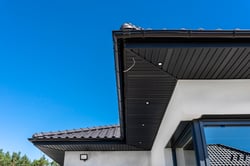

What are fascia boards?
Before diving into why fascia boards may be damaged (and discovering who the culprit is) it’s important to understand what fascia boards are and why they’re important.
Fascia boards are long, thin boards that run along the underside of a home’s roof edge and help to cap rafters and hold gutters in place. Fascia is easily visible to onlookers and extends along the full length of the home in either direction. Often used in conjunction with soffits, fascia boards and soffits help provide a more finished look to your home’s roofline. Because fascia boards are a highly visible part of the roofline, they are typically constructed of attractive yet hardy materials like wood, PVC, fiber cement, vinyl, or aluminum.
But fascia boards aren’t purely aesthetic. Fascia boards also provide additional moisture protection by preventing water seepage and offering additional support to your home’s roof shingles and gutters. Fascia boards are a necessary and essential component of a home’s protection against the elements. In this way, fascia is equal parts fashion and function.
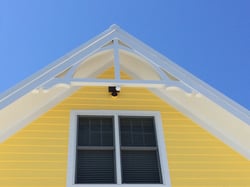
What kind of pests can cause holes in my home’s fascia?
Now that we understand the full spectrum and importance of fascia boards, we can address what pests may be putting them at risk.
There are a few viable culprits when it comes to holes in a home’s fascia boards. Woodpeckers have been known to hammer away holes into a home’s fascia in search of insects to eat. Termites can also chew holes through wood fascia, tunneling far beyond your home’s exterior. But while definitely possible, woodpeckers and termites are not the most common culprit for holes in your fascia. The pest most likely responsible for drilling holes in your fascia boards is actually carpenter bees.
Female carpenter bees will bore into fascia each spring to create the perfect nesting sight. Carpenter bees will create small, perfectly round entry holes in your fascia, often creating many entry points. Unfortunately, carpenter bees rarely stop as just a few small holes. Carpenter bees then construct perpendicular tunnel off-shoots from these entry points that can be up to 8 inches long. These entry holes and tunnels are called galleries, and they can often be quite extensive. Female carpenter bees may build between 6-8 of these tunnels for egg-laying purposes. Sometimes, the tunnels aren’t visible at all from the outside and the only indication of the presence of carpenter bees may be the small entry holes initially drilled.
That may not sound too disastrous until you consider that many female carpenter bees will return to existing galleries for several consecutive years. Each year, the same pattern of tunnel drilling will repeat, compounding damage and creating significant fault lines and holes in your home’s fascia. Over the years, tunnels that started as just a few inches in size can expand to 10 feet in length.
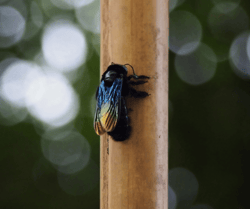 Carpenter Bee
Carpenter Bee
What are carpenter bees?
Carpenter bees are of the broad Xylocopa genus, which is made up of roughly 500 different bee species and 31 subgenera. Aptly named, carpenter bees were dubbed such due to their wood-burrowing nesting habits. Nearly all species in this genus bore into hard plant material with very few outliers who instead build tunnels in soil. The genus of carpenter bees was named by French entomologist Pierre André Latreille who used the Greek word for “woodcutter” as its derivative.
Unlike most wood-boring insects, carpenter bees do not eat the wood they drill into. Boring holes and vast tunnels is purely for nesting purposes and to create safe hideaways for female carpenter bees to lay their eggs. Because carpenter bees don’t eat the wood, there are often sawdust piles and trails left in their wake as they drill and construct. They are not social insects and tend to live in solitude, creating individual nests in trees or worse, the frame, eaves, siding, or fascia boards of your home.
Carpenter bees can be difficult to identify due to their appearance closely resembling other bee species, particularly bumblebees. In fact, bumblebees and carpenter bees are the two largest bee species that are native to the United States. While they look very similar, there are a few key differences that help professionals tell them apart. Carpenter bees don’t have the same hairy yellow markings on their abdomens that bumblebees do; instead, carpenter bees’ abdomens are smooth and shiny. They also often have blackish-blue abdomens and/or wings and tend to be larger than the average bumblebee.
Female carpenter bees can be easily distinguished from males by their black heads. Male carpenter bees’ heads are also predominantly black, but they have noticeable white markings near the front of their head.
Carpenter bee entering its home
How do I know if there are carpenter bees in my fascia?
Carpenter bees aren’t always evident in their infestation of your fascia. Especially in the beginning stages, it can be difficult to identify the presence of carpenter bees. Here are a few things to look out for this spring and summer:
- You see a carpenter bee. This might seem obvious, but it becomes less so when you consider that carpenter bees are easily confused for bumblebees. If you’re uncertain that the bee you’ve encountered is a carpenter bee, consider its behavior. Carpenter bees will be hanging around wooden structures such as your home’s fascia or eaves, whereas bumblebees build nests in the ground and remain nearby, buzzing about flower beds and other low plants.
- You hear a carpenter bee. Carpenter bees can be surprisingly noisy in their wood-boring and tunnel-building. You may hear a buzzing, humming, or vibrating sound from inside or outside your home.
- You see smooth, round holes in your fascia boards. These holes may be indicative of carpenter bee entry holes.
- You notice staining on your fascia boards. Carpenter bees will excrete as they work and these droppings will often result in dark, drip-like stains. Depending on the lightness of the wood, these stains may also look yellowish in color.
- You see small piles of sawdust. As carpenter bees bore into wood, small piles of frass or sawdust may accumulate below the drill site. Sawdust may also appear in a line following the bee’s drilling direction.
- Your fascia gives way. Hopefully, your carpenter bee infestation would be discovered before this level of damage can occur, but if all signs are missed for a few years, damage to fascia can accumulate to the point of giving way. This may result in split fascia boards, drooping fascia, or irreparable water damage to your fascia boards.
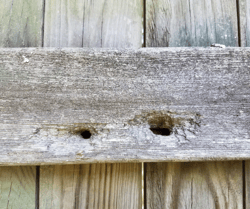 Example of carpenter bee damage and entry holes
Example of carpenter bee damage and entry holes
How can I prevent carpenter bees in my fascia?
At EcoShield, we believe prevention is always the best approach to pest control. While preventing carpenter bees entirely can be tricky, there are several ways to make your home less hospitable to carpenter bees.
- Paint or stain fascia boards. Carpenter bees prefer untreated wood, so painting or staining fascia boards may deter them from nesting.
- Fill abandoned holes. Carpenter bees are known to return to old nesting sites, so by filling entry holes to old nests, you may prevent them from being able to renest in your fascia the following year.
- Install a carpenter bee hotel. These structures are specifically built with pre-drilled holes to appeal to carpenter bees and encourage them to nest in the provided structure rather than your fascia.
- Hire a trusted pest professional like EcoShield. A trusted pro can offer custom treatment plans and expert guidance in preventing carpenter bees from infesting your fascia boards. They can help identify potential problem areas and even point out signs of existing carpenter bee damage.
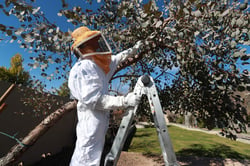 EcoShield stinging insect technician
EcoShield stinging insect technician
What do I do if there are carpenter bees in my home’s fascia?
If carpenter bees are damaging your home’s fascia boards, don't delay. The longer carpenter bees are present, the more likely they are to reproduce and further damage your fascia boards and other structures. Call EcoShield at the first indication of carpenter bees and prevent costly remediation from late-stage infestation. We have the expert knowledge and tools to get rid of your carpenter bee infestation and ensure they don’t return! Give us a call today or fill out the form on this page for your free no obligation quote.